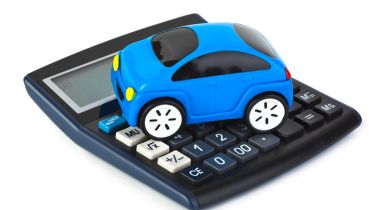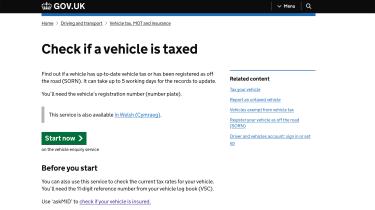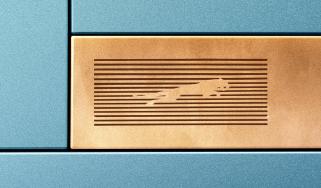Car tax 2024/2025: Understanding VED road tax
Confused by VED road tax? Our comprehensive guide explains how much you'll pay to tax your car in the 2024/25 financial year

Vehicle Excise Duty (VED), also known as road tax, car tax or the road fund licence, is a UK-wide tax paid by drivers in order to legally drive or park a car on the public road. VED road tax was initially introduced in the early 20th century, but numerous changes over the years mean it is now rather confusing to say the least. Don’t worry though, as we’re here to guide you through the different VED car tax bands, how much road tax costs, how to pay your road tax and what you need to do from a road tax perspective if you sell your car or take it off the road.
If you’re buying a new or used car, the chances are you’ll need to pay VED road tax, although there are a few exceptions to this rule. For example, electric cars and other zero emissions vehicles have long been exempt from road tax, although this will all change as of April 2025 – more on that later.
After that point, the only vehicles able to escape the dreaded yearly charge are classic cars aged over 40 years old, as well as vehicles used by disabled people or cars used to transport disabled passengers.
The amount of car tax you pay will be based partly on the amount of emissions produced by the car. However, as cars have become cleaner and more efficient, the government has made a series of changes to the car tax bands to prevent a shortfall in the amount of car tax revenue collected.
The Office for Budget Responsibility estimated that £9.4billion will be raised by Vehicle Excise Duty by 2027/28 – up from the £7.3 billion collected for the 2022-23 tax year, or £5.8 billion in the year prior to the VED car tax changes in 2017. Revenue has remained on an upward trajectory since the 1990s, increasing rapidly in recent years, but the emissions-based system is likely to see revenue fall in the long term as more people transition to EVs.
Despite popular misconceptions, ‘road tax’ isn’t specifically a tax to be used for the upkeep or creation of public highways. The cash was only ringfenced until 1937, thereafter going into the central pot to be spent on whatever the Government and Treasury desires.
Read on for a more detailed explanation of VED car tax bands, how much road tax is, and how to pay…
How much is my road tax?
How much you pay for your VED road tax all depends on which tax system applies to your car and that is determined by when the car was first registered. With the exception of inflationary increases, changes to the road tax system are not retrospectively applied, so the system that was in place when a new car was first purchased will continue to apply for as long as that car is on the road. This is regardless of whether or not new road tax systems are introduced.
If you're buying a new car today, you will pay road tax based on the current tax band system that was introduced on 1 April 2017, and has been regularly adjusted for inflation. If you are buying a used car that was registered before April 2017, then the tax rate you pay will be based on the old VED system that applied at the time of first registration, even if the car is still in production.
The first thing to know about the UK’s current road tax system is that it is split into two main rates. The first tax rate applies during a new car’s first year on the road, and varies depending on how much carbon dioxide it emits. After a new car has spent a year on the road, it will then be taxed on a second system; this is not affected by CO2 emissions, but is determined by how much the car cost when it was new.
It’s worth noting that while hybrid-powered cars used to benefit from a discounted yearly rate and electric cars dodged the charge altogether, this will change in April 2025, with all cars built after April 2017 paying the same standard rate of £190 – a figure that may increase slightly come that time.
How is the car tax calculated?
VED car tax is calculated depending upon a few different factors. The first-year of road tax is included in a car’s on-the-road (OTR) price and is based on its carbon dioxide emissions. It ranges from £0 for zero-emission cars to £2,745 for models that emit 255g/km or more.
Formerly, nearly all new diesel cars sat one emissions band higher for the first year rate because the Treasury decided to increase the first-year rate for diesels not meeting “the latest emission standards” – technically known as RDE2. It became a legal requirement for new diesel cars to meet RDE2 requirements in January 2021, so this is no longer an issue.
Regardless of this, sitting in a higher first-year tax band is no great hardship: many buyers will only be subject to a relatively minor one-off extra cost, which will be absorbed into the car’s on-the-road price. For example, as you'll see in the table below, cars emitting 111g/km to 130g/km of CO2 pay a first year rate of £220.
After the first year, all cars pay a flat rate of VED road tax or £190, except for EVs which currently pay nothing. From 1 April 2025, electric cars will lose their VED exemption.
Road tax for cars first registered from 1 March 2001 to 31 March 2017
The Government first introduced emissions-based vehicle taxation in 2001, when it created tax bands for cars which increased in amount depending on the emissions produced. When the most recent road tax format changes took place on 1 April 2017, all cars registered in the previous way had their tax frozen at the following rates:
VED road tax for cars registered 01/03/01 to 31/03/17. This older system of road tax is also subject to inflationary increases.
| VED Band | CO2 Emissions | Annual rate |
| A* | Up to 100 g/km | £0 |
| B | 101-110 g/km | £20 |
| C | 111-120 g/km | £35 |
| D | 121-130 g/km | £160 |
| E | 131-140 g/km | £190 |
| F | 141-150 g/km | £210 |
| G | 151-165 g/km | £255 |
| H | 166-175 g/km | £305 |
| I | 176-185 g/km | £335 |
| J | 186-200 g/km | £385 |
| K** | 201-225 g/km | £415 |
| L | 226-255 g/km | £710 |
| M | Over 255 g/km | £735 |
* Zero rate VED to be abolished as of 01 April 2025
**The Band K rate also applies to cars that were registered before 23 March 2006 and have an emissions figure over 225g/km.
Tax bands for cars registered after April 2017
UK VED tax bands changed in April 2017 and are no longer calculated solely based on a car's CO2 output. All cars registered after 1 April 2017 have to pay the first year tax rate based on emissions, but from the second year the standard rate is applied.
As of April 2025, the cheapest £0 VED rate will be abolished, meaning all cars built after April 2017 – regardless of whether they are petrol, diesel, hybrid or electric-powered – will pay the standard flat rate of road tax. This means that EVs are no longer exempt from VED and hybrid cars no longer benefit from a slight discount.
As before, cars that have a list price of £40,000 or more will also pay the Expensive Car Supplement, also known as the ‘luxury car tax’. This involves paying a £410 annual supplement (on top of the £190 per year standard rate) for five years from the second year to the sixth year after first registration and as with the other tax bands these amounts are subject to inflationary increases. All EVs and other zero emissions vehicles registered after April 2025 and costing over £40,000 will also be liable to the surcharge.
| CO2 emissions (g/km) | Standard petrol/diesel rate | First year rate |
| 0* | £0 | £0 |
| 1 to 50 | £190 | £10 |
| 51 to 75 | £190 | £30 |
| 76 to 90 | £190 | £135 |
| 91 to 100 | £190 | £175 |
| 101 to 110 | £190 | £195 |
| 111 to 130 | £190 | £220 |
| 131 to 150 | £190 | £270 |
| 151 to 170 | £190 | £680 |
| 171 to 190 | £190 | £1,095 |
| 191 to 225 | £190 | £1,650 |
| 226 to 255 | £190 | £2,340 |
| Over 255 | £190 | £2,745 |
* Zero rate VED to be abolished as of 01 April 2025
How to pay your car tax
Fortunately, the process of paying your car tax is an easy one. The easiest way to do this is on the Gov.uk website, where there’s a page entitled ‘Tax your vehicle’. Here you follow a straightforward step-by-step process, most likely using a reference number from a V11 reminder letter you’ve been sent by the DVLA.
You can also pay car tax at most Post Offices if you take your V5C with you. Additionally, the DVLA's 24 hour vehicle tax service can be telephoned on 0300 123 4321.
How is car tax monitored?
Car tax is monitored by the police and DVLA through a network of automatic number plate recognition cameras used in conjunction with the DVLA database, although this system is still relatively new.
The system for collecting and enforcing road tax was overhauled in 2014, when the Government abolished the tax disc. After 93 years, it was decided that a small circle of paper in your windscreen was no longer necessary, and its abolition made the whole system cheaper to run. There is a catch, however, as you’ll find out below.
The current road tax set-up makes it tougher for those seeking to avoid paying road tax. Rather than the visual check that the tax disc made possible, the authorities now rely on number-plate recognition cameras to determine that a vehicle has been taxed.

Although it’s no longer a requirement to display a tax disc in your windscreen, this doesn’t mean you don’t have to pay. The DVLA will send you a reminder when your road tax is up for renewal in the time-honoured fashion, and you can continue to pay your road tax online, over the phone or at the Post Office.
The existing options of paying for 12 or 6 months tax up front are still on offer (for most tax levels), but there’s also the option of paying your car tax monthly. This monthly option arrives in tandem with the facility to pay your road tax by Direct Debit, although when paying by Direct Debit you will pay slightly more as a five per cent surcharge is added on to the monthly amount. One-off annual payments come with no extra charges.
The key advantage of paying your car tax by Direct Debit is that the DVLA will continue taking the payments until you tell them to stop. It means that you’ll no longer need to remember to pay your road tax once a year, although of course you still need to ensure that your car has valid insurance cover and an MoT certificate if it's over three years old.
Taking your car off the road
If you are not going to use your car for a long period (anything longer than six months) you can use a Statutory Off Road Notification (SORN) to avoid paying road tax while you're not using it. However, off the road means off the road – you can’t declare SORN unless you have off-street parking, a garage or some other kind of storage that’s away from the public highway. Even if a car is parked in the road for a long period, it needs to have road tax to be parked there – ergo it also has to have an MoT and insurance to get tax in the first place.
You can make a SORN declaration at any time if you have the V5C registration document, or the more common way is to declare SORN when the vehicle’s road tax reminder comes through the post from the DVLA. Then you can use the 16-digit renewal code to declare SORN. Once the vehicle has a SORN, you’lll get written confirmation in the post, but you won't get any annual reminders about the vehicle's SORN status.
If you declare SORN while there’s time left on the current road tax, you can reclaim the outstanding amount and get it refunded, although it will only be for a full month’s tax, so from the first of the month after you declare a SORN.
When you want to put your vehicle back on the road, simply tax the vehicle and your SORN is cancelled automatically. The only time you can drive a vehicle that has been SORNed is if you’re going to a pre-booked MoT appointment or other vehicle test. Drive it on the road for any other reason, and you could face a fine of up to £2,500.
If you’re making a SORN declaration for a vehicle that isn’t yours (if the owner has passed away, for example), then you need to apply for SORN by post using form V890 and filling out the relevant information, along with the information needed from the vehicle’s V5C registration document.
What happens to road tax when you sell your car?
Under the current system, any remaining road tax you have when you sell your car will not transfer to the new owner with the vehicle. Instead, the seller can get a road tax refund on any tax remaining on the vehicle, while the buyer has to pay to re-tax the car.
The tax refund on a sold car will be sent automatically when the DVLA receives notification that the car has been sold, scrapped, exported or taken off the road with a Statutory Off Road Notification (SORN).
Sellers are expected to inform the DVLA of any change of ownership straight away or face a £1,000 fine. If they don’t, they could also still be liable for speeding or parking fines incurred by the new owner.
Information on whether or not a car is taxed is available online via the Government website. All you need is the make and model of the car plus the registration number.
What is pay-per-mile tax?
There’s plenty of speculation about how the government will eventually fill the financial void as more and more drivers switch over to electric cars. Under the current rules, EVs do not incur any VED road tax, but there is some belief that pay-per-mile road tax (also known as ‘road pricing’) could be implemented in future to replace the existing VED road tax structure.
If pay-per-mile road tax is ever introduced, drivers would pay a fee that’s calculated based on the miles they have covered over a set time period, as opposed to the current fixed yearly charge. While there’s no idea of exactly how much the government would charge per mile, it had been reported that the fee could be around 12 to 15 pence per mile.
If drivers were to be charged this amount, an average annual mileage of 6,500 miles would cost around £975, which is a significant increase over the current rate paid by most vehicle owners. While it is currently unclear how the charges would be calculated, some have suggested that the total amount each year would be tallied from mileage records taken during MOT testing.
It was rumoured that a pay-per-mile scheme was to be introduced by the Labour government in its first Autumn Budget in October 2024. However, sticking by what it told Auto Express that it has “no plans to introduce road pricing”, this type of scheme was not brought in, to the relief of many.
How much is your car worth? Find out with our free car valuation tool...








